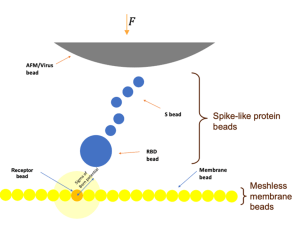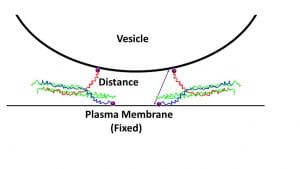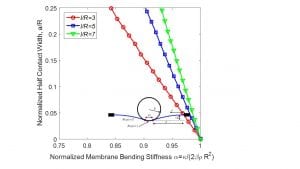We are interested in the biomechanics of how things get out of or into a cell. We work on two specific problems:
- Molecular details of synaptic transmission, in which bundles of SNARE proteins cause docking and fusion of synaptic vesicles to the cytosolic side of the plasma membrane.
2. Viral entry into cells, specifically that of the Ebola virus
Penetration of Cell Surface Glycocalyx by Enveloped Viruses Is Aided by Weak Multivalent Adhesive Interaction
Viral infection usually begins with adhesion between the viral particle and viral receptors displayed on the cell membrane. The exterior surface of the cell membrane is typically coated with a brush-like layer of molecules, the glycocalyx, that the viruses need to penetrate. Although there is extensive literature on the biomechanics of virus–cell adhesion, much of it is based on continuum-level models that do not address the question of how virus/cell-membrane adhesion occurs through the glycocalyx. In this work, we present a simulation study of the penetration mechanism. Using a coarse-grained molecular model, we study the force-driven and diffusive penetration of a brush-like glycocalyx by viral particles. For force-driven penetration, we find that viral particles smaller than the spacing of molecules in the brush reach the membrane surface readily. For a given maximum force, viral particles larger than the minimum spacing of brush molecules arrest at some distance from the membrane, governed by the balance of elastic and applied forces. For the diffusive case, we find that weak but multivalent attraction between the glycocalyx molecules and the virus effectively leads to its engulfment by the glycocalyx. Our finding provides potential guidance for developing glycocalyx-targeting drugs and therapies by understanding how virus–cell adhesion works. Xinyu Cui, X. Frank Zhang, and Anand Jagota, Journal of Physical Chemistry B 2023 127 (2), 486-494.
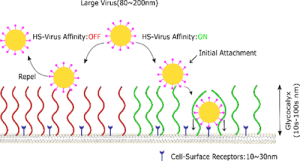
Length of mucin-like domains enhances cell-Ebola virus adhesion by increasing binding probability
The Ebola virus (EBOV) hijacks normal physiological processes by apoptotic mimicry to be taken up by the cell it infects. The initial adhesion of the virus to the cell is based on the interaction between T cell immunoglobulin and mucin domain protein, TIM, on the cell surface and phosphatidylserine (PS) on the viral outer surface. Therefore, it is important to understand the interaction between EBOV and PS and TIM, with selective blocking of the interaction as a potential therapy. Recent experimental studies have shown that for TIM-dependent EBOV entry, a mucin-like domain with a length of at least 120 amino acids is required, possibly because of the increase of area of the PS-coated surface sampled. We examine this hypothesis by modeling the process of TIM-PS adhesion using a coarse-grained molecular model. We find that the strength of individual bound PS-TIM pairs is essentially independent of TIM length. TIMs with longer mucin-like domains collectively have higher average binding strengths because of an increase in the probability of binding between EBOV and TIM proteins. Similarly, we find that for larger persistence length (less flexible), the average binding force decreases, again because of a reduction in the probability of binding. Cui, X., Lapinski, N., Zhang, X. F., & Jagota, A. (2021). Length of mucin-like domains enhances cell-Ebola virus adhesion by increasing binding probability. Biophysical Journal, 120(5), 781-790.
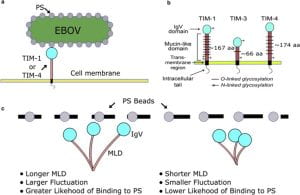
Adhesive contact between cylindrical (Ebola) and spherical (SARS-CoV-2) viral particles and a cell membrane
Most of virus internalization is mediated by the receptor-dependent adhesive interaction between cell-surface and virus-surface molecules. During this process, the adhesive forces tend to bend and pull against tension to wrap around the viral particle. To understand the mechanism of this process can help us understand how the virus infect host cell and develop the cure. We have built two models: one in which the viral particle is cylindrical (representative of a filamentous virus such as Ebola) and another in which it is spherical (such as SARS-CoV-2 and Zika). In the limit where bending dominates, for sufficiently large values of normalized bending stiffness, there is no adhesion between viral particles and the cell membrane without applied force. (The zero external force contact width and pull-off force are both zero.) For large values of normalized membrane tension, the adhesion between virus and cell membrane is weak but stable. (The contact width at zero external force has a small value.) Our results for pull-off force and zero force contact width help to quantify conditions that could aid the development of therapies based on denying the virus entry into the cell by blocking its initial adhesion.


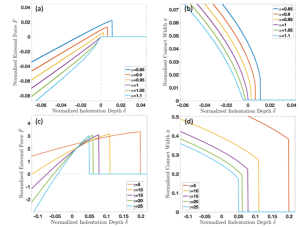
Meso-scale model for virus-cell adhesion: spike-like protein and meshless membrane
A critical step in virus infection is its adhesion and uptake by the host cell. This step starts when a receptor binding domain (RBD) on the viral surface binds to its receptor on the cell membrane. Some research work shows that the flexibility of spike proteins can make easier for the RBD to find the receptor on the membrane. To study this, we have developed a generic model with flexible spike-like protein and meshless membrane to answer the question: how do the flexibility of spike-like protein, the density of receptor and binding affinity affect the binding probability?
